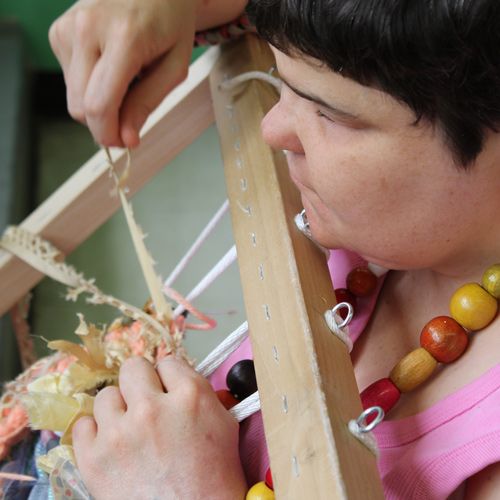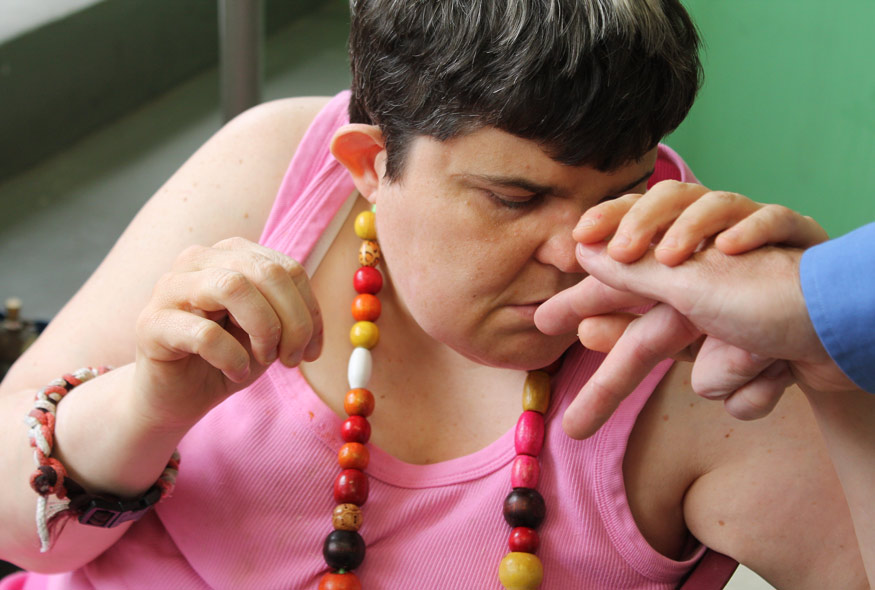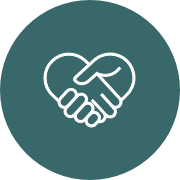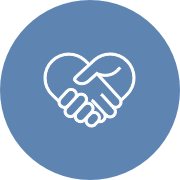
In touch
“Beautiful.”
“Wonderful.”
“Good.”
Stephanie Petro is a vocational arts and education supervisor at RHD’s Center for Creative Works, and she gives enthusiastic feedback to Kelly, an artist at the studio. Communication can be a challenge for many of the artists at CCW, a unique, creative arts day program for people with intellectual disabilities. Kelly is blind and deaf, so communication means that Stephanie takes Kelly’s hands in hers and makes the sign for “beautiful” – four fingers and thumb coming together in a peak at her chin and then expanding, almost blossoming, in front of her face – as Kelly works on her sculpture. Kelly claps her hands excitedly, both at the positive feedback over her work and at the fact that she can have this conversation in the first place.
“She’s really patient with me,” Stephanie said. “She knows I’m still learning sign language. She’s so fast; I know she’s kind of waiting for me sometimes. But I think Kelly appreciates that I’m learning her language.”

Stephanie taught herself what’s called “tactile signing” – a version of sign language specifically for people who are deaf and blind, where the person puts his or her hands over the signer’s hands and feels the shape, movement and location of the signs. She did this on her own time, because she felt like Kelly should be able to communicate and interact in the studio. She felt like Kelly deserved that.
“Kelly didn’t have a lot of interaction or engagement, and I thought it was pretty obvious that she was not happy,” Stephanie said. “She’d self-injure, and she’d get frustrated that she couldn’t communicate – the same way anybody who wasn’t able to talk would get frustrated.
“And I just thought, you know … no. That’s not good enough. We can do better. We can do more.”
Stephanie had read Helen Keller’s book, and found a video on tactile signing at the local library and began learning letters and words – enough to get started. Soon they were having real conversations, and Kelly not only became much happier in the studio, she started taking giant steps forward in her work.
Kelly would sit all day with a bag full of yarn and use her fingers to weave the yarn into long chains. The staff at CCW picked up on the finger weaving as a creative technique that had potential to become art. Expanding that activity into an organized art form would require communication and creative vision, and Stephanie worked to make sure that happened.
Stephanie began introducing more and more materials to her and supporting her as she learned to weave materials, through, around, in, and out of various found objects and into amorphic forms that became increasingly beautiful. Stephanie could communicate with Kelly to talk about what the forms meant to her, and what Kelly was trying to build with each sculpture.
“We’re just thinking of ways for her to be in control of what she’s doing, to have options and make decisions,” Stephanie said. “Textiles are so important to her, because everything she knows is by touch. She’s very intelligent; she knows what’s up. But too many of her teachers just didn’t know how to talk to her in her language. That’s how it is with a lot of our clients – you have to learn their language, sometimes. Well, this is Kelly’s language.”
Kelly has shown work in several shows, and she’s become much more active in the studio. All across the country, RHD staff are committed to person-centered services. RHD programs meet people where they are; and that certainly includes reaching out in various ways to communicate. One of the greatest needs any person has is the desire to be heard – in all the forms that entails. The lengths Stephanie has gone to in order to make sure Kelly has the chance to be heard is an example of what RHD strives for.
“Kelly’s story is really a testament to how powerful art can be as a vehicle for communication and self-expression for someone who has so little access to the types of communication and self-expression the rest of us have,” CCW director Lori Bartol said. “And it’s a statement about how amazing, dedicated and creative many of our staff are who take on these challenges every day.”


